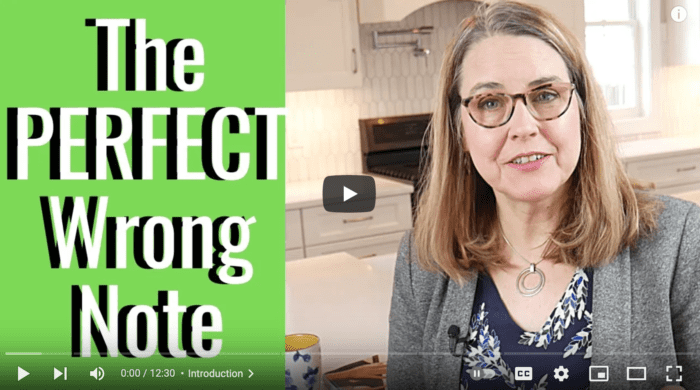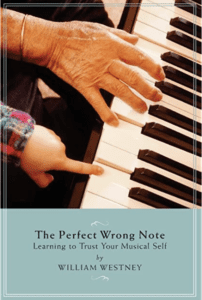Making mistakes in piano practice can be discouraging and frustrating, but with the right mindset, mistakes can actually be a valuable tool in improving your playing.
One of my favorite books on piano playing, teaching, and practicing is The Perfect Wrong Note, by William Westney. By adopting the right mindset and techniques, you can turn your mistakes during piano practice into opportunities for growth and improvement.
Whether you’re a beginner or an experienced pianist, The Perfect Wrong Note offers valuable insights and strategies for improving your playing and making the most of your practice time.
In this blog post, I’ll summarize some of the insights and takeaways that I got out of the book.

Takeaway #1: Traditional music instruction can be stifling.
The book argues that children have a natural passion for music that is often lost during the process of music lessons. When a child first experiences music, it is a fun and creative process. However, when they begin lessons, they are often forced to sit still and listen to instructions from a teacher who is deemed to have more knowledge.
This approach can stifle their creativity and enthusiasm for music-making.
High-level piano teaching is often focused on controlling the student rather than encouraging their own expressive impulses. This approach can cause students to develop feelings of perfectionism and lead to inhibition.
However, Westney argues that it is possible to regain this enthusiasm by rethinking what it means to play “correctly” and “incorrectly” and reevaluating what we consider “mistakes.” The book encourages music teachers to help students connect with their own motivations, to foster a love of music that will last a lifetime.
Takeaway #2: Embrace wrong notes.
In The Perfect Wrong Note, Westney discusses the concept of embracing mistakes in order to approach playing a musical instrument in a more liberated and non-judgmental way.
Instead of feeling disappointed or inadequate when making a mistake, one can view it as valuable feedback to reflect on and modify their approach in order to achieve the desired result.
This approach can be particularly beneficial for those struggling with perfectionism and self-acceptance in their musical practice, as the fear of making a mistake can lead to physical tension and inhibition.
Westney emphasizes that embracing mistakes allows for a more objective and curious approach to playing, which can lead to greater growth and self-acceptance.
Overall, the book promotes a mindset shift towards viewing mistakes as opportunities for learning and growth, rather than something to be feared or avoided.

Takeaway #3: Be aware of “careless” vs. “honest” mistakes.
Westney points out that there is often an unreasonable expectation of perfection when learning music in the classical music world. This expectation doesn’t allow us to make “honest mistakes” as we learn the enormously complicated physical act of playing the piano.
“Honest” mistakes occur when the body is expressing itself without restriction, even though when you are focused and attentive. These types of mistakes provide valuable feedback that can be used to adjust your approach and improve over the course of your practice session.
“Careless” mistakes, on the other hand, occur when you are not paying attention, and when you neglect to address the mistake at the time it happens.
By recognizing the difference between these two types of mistakes and focusing on avoiding careless mistakes, the quality of your practice can greatly improve.
Westney emphasizes that mistakes are not inherently “bad,” but rather an indication that something needs closer attention and review. This mindset shift can help students approach their musical practice with more curiosity and self-acceptance, rather than striving for unattainable perfection.
Takeaway #4: Play with gusto!!
The fourth takeaway from the book is to play with gusto, or make “juicy mistakes,” as Westney calls them. It is important to commit to what you are playing and make strong, vibrant sounds, as a a fear of making a mistake can result in a tentative sound.
Playing with 100% conviction and making your mistakes big and juicy, you can get quicker feedback on what needs to be practiced. This concept can be confusing because we have been taught to avoid making mistakes when practicing, but ultimately, you want to be fearless and strong when performing on stage, which won’t happen if your practicing is tentative and cautious.
The right notes should result from confident and decisive movements, not from playing it safe during practice. Westney emphasizes that mistakes are evidence of something that needs closer attention, and making honest mistakes can provide good feedback for the body.
Overall, playing with gusto and making juicy mistakes can lead to more confident and intentional playing.
Takeaway #5: Trust your intuition
In The Perfect Wrong Note, Westney emphasizes the importance of trusting your intuition when playing the piano. Being present and mindful during practice enables you to tune into and respond to your intuition.
The principle of deliberate practice requires your mind to be engaged throughout your practice time. Using your imagination and thinking about how you want to express yourself more authentically can help.
However, it’s important to remember that just because something feels intuitive and right one day, it doesn’t always have to be played the same way. Westney shares an example of when he wrote “melancholy” in his music one day but felt like he wanted the same passage to sound jaunty the next day.
Trusting your intuition means that when you know a piece, you can play it differently on different days as long as the expression comes from a place of authenticity.
Micromanaging every movement you make and telling yourself there is only one right way to play a passage sets you up for physical inhibition and detachment from your body. Instead, be mindful, be present, and trust your intuition.
Conclusion
The Perfect Wrong Note offers insights and strategies for serious piano students, adult learners and teachers. Westney discusses his creative twist on masterclasses, called the Un-masterclass, as well as his ideas for bringing creativity into teaching. The book also covers performing, performance anxiety, and adapting teaching ideas to personal piano practice.
HAPPY PRACTICING!
This post contains affiliate links. If you click on a link and make a purchase, I will receive a small commission at no cost to you.

One Response